|
SKY -
May
2021
Please use our
A-Z INDEX to
navigate this site or return HOME
|
|
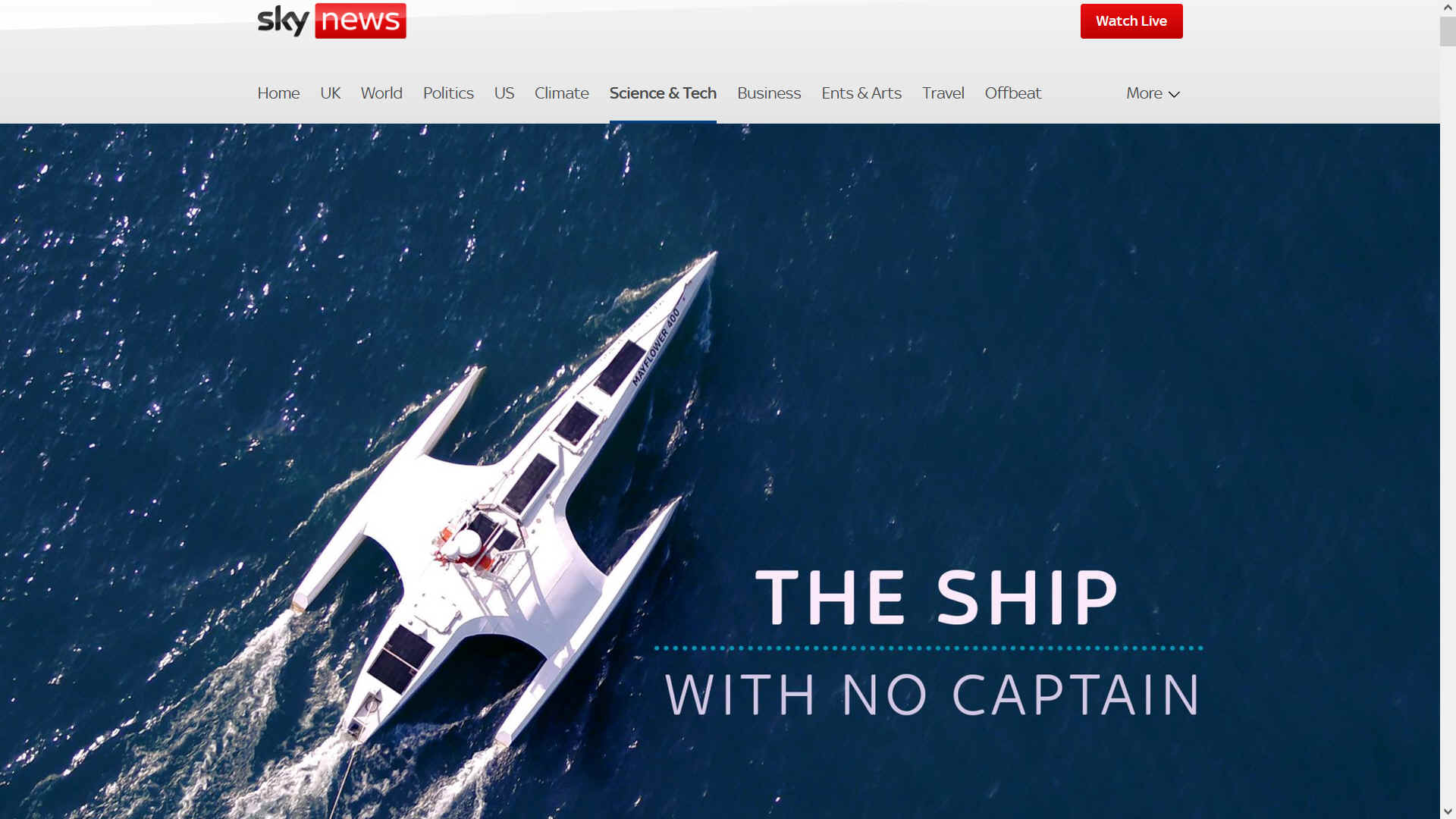
MAYFLOWER
ATLANTIC VOYAGE - The Mayflower's direction of travel is the
reverse of the
Scout and Voyager
autonomous Atlantic
attempts that took advantage of trade winds. The Mayflower will be
heading into prevailing winds and currents. If sail powered, she would
need to tack. But powered by a
diesel
engine, with support from the deck mounted solar panels, there may be no
need for that - except, that we saw her struggling when out at sea.
Energy from nature is used to power the onboard AI and
satellite
comms. Many media reports inaccurately refer to wind power as a feature
of the MAS, but you can plainly see that there is no wind turbine or
wing-sail. Lidar, Cameras and Radar are commonly used to navigate reaper
drones, robotaxis
and driver-less
trucks. There is no reason why such a system should not perform well
on the high seas.
|
|

SKY NEWS MAY 2021 - MAYFLOWER 400 SHIP WITH NO
CAPTAIN
No captain. No crew. No human contact.
Within the next few weeks, the world's most technologically advanced
ship will slip its moorings in Plymouth and begin a pioneering
3,000-mile journey across the Atlantic.
And it will do so without any human intervention.
The Mayflower 400 is named after the original triple-masted vessel that
took the Pilgrims
to the New World four centuries ago.
But although it will follow the same route to New England, the 21st
century ship is nothing like its slow, heavy, wooden forbearer.
It's a sleek solar-powered trimaran with an AI
captain – a computer that's learned to spot hazards and navigate
around them.
It's not just a proof of concept for a future of autonomous
ships, large and small, that could ply the
world’s oceans without a crew.
It's also a floating laboratory, packed with robotic instruments that
will sample the water, listen for whale song, and monitor the impact of
human activity on ocean health.

Much
as robotic
rovers are now exploring Mars, Mayflower 400 will enable scientists to
investigate parts of the ocean that would otherwise be beyond reach.
In a changing
climate, it's vital to understand what's happening in our oceans. They
are the planet's lungs and larder.
And they are under threat.
With its dart-shaped central hull, stabilised by wing-like outriggers,
Mayflower 400 looks from above like a Starfleet fighter from Star
Trek.
It's 15 metres long, half the length of the original Mayflower. And with its
sleek form it cuts through the water, barely leaving a wake. [check
facts]
With no humans on board, there’s no need for headroom. Nor are there
bunks, toilets or a kitchen. This is pure machine, a robotic ship designed
to do science in the remotest parts of the world’s ocean.
It’s powered by solar
panels, supplemented with a frugal diesel-electric
engine. In theory, it could spend long periods at sea.
The Mayflower 400 is currently in sea trials in Plymouth Sound, with a team
from IBM and ProMare
tweaking the software to prepare the ship for its maiden solo voyage.
|
|
THE TECHNOLOGY
The AI captain is in charge. That's the nickname given to the computer
'brain' of the Mayflower 400 by the engineering team.
Just like a human captain, it is constantly scanning the horizon
for threats.
Satellites provide a map of nearby ships, a radar sweeps its
surroundings, and cameras feed into the computer's vision system.

HULL
DESIGN - Contrary to media reports, the trimaran kicks up quite a bit of
froth as she pushes through Plymouth Sound. Reports should be accurate and
not make statements that will misinform or puzzle readers. We were a little
confused at Sky's assertion as to gliding through the water, where many
other multi-hulls produce significantly less wash. See Fort Bovisand in the background.
One of our volunteers did his BSAC diver training at the Fort, when it was
operating as Britain's number one diving school, some years ago.
It knows what objects are, trained with more than two million images of
ships, whales,
floating shipping containers, and even paddle-boarders - anything it
might encounter along the way, however unlikely.
And with each potential hazard it will assess the risk, and change speed
and course, as necessary, following the international rules of the sea.
If all else fails, it will stop dead in the water and reassess.
The Mayflower 400 is a proof of concept. In future, artificially
intelligent captains could be built into cargo vessels, taking over
from humans over long stretches of open ocean, just as autopilots are
used on passenger aircraft.
But in the short term, this is a floating lab for ocean science – with
human researchers able to download live data, and images, back on
land.
|
|
BRETT PHANEUF
The Mayflower Autonomous Ship project was the idea of Brett
Phaneuf, a submarine
builder with expertise in ocean archaeology and oceanography.
Brett has come full circle – growing up not far from Plymouth,
Massachusetts, and now based in Plymouth, UK. He has made the reverse
journey of his autonomous ship's maiden voyage.
He and his wife Ayse Phaneuf, also a marine archaeologist, dedicate
their time to supporting marine research and exploration through their
non-profit group ProMare.
"It gives your life meaning," says Brett, considering his work
from various projects and responsibilities.
Is he nervous about the autonomous ship's first mission? No. Whatever
happens it's all about the learning, he says: "Only time will
tell."
|
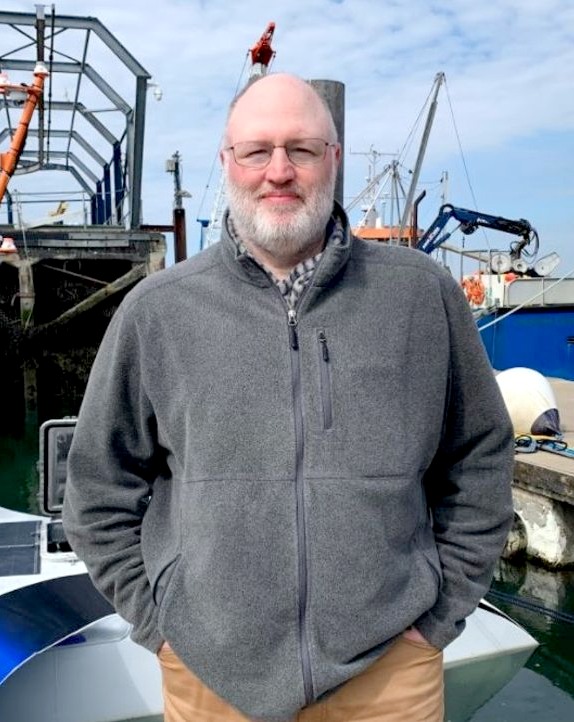
|
|

MORE
SOLAR PANELS - The solar panel array has roughly doubled since
launch in September 2021. Even so, electricity generating performance
will be limited, compared to PlanetSolar's array totalling some 537 m2.
The Mayflower has a more efficient hull in principle, being a trimaran
with less windage. Meaning that she will require less energy pro-rata.
But her wash at speed is interesting.
Two
ships carrying Pilgrims left Plymouth bound for America; Mayflower and Speedwell. Speedwell was in bad repair and kept taking on water despite
repairs, and never made it to the US. Mayflower was built in Harwich, an
armed merchant vessel boasting three masts that were 30 metres tall and up to 7,5 metres in width.
Despite adverse weather, she made it across the Atlantic to found a
colony with the help of the indigenous Wampanoag, skilled farmers,
hunters and fishermen. The native Americans helped the Pilgrims to find
their feet and found a thriving colony.
|
THE SCIENCE
We know more about the surface of Mars than we do about our own ocean.
It covers more than 70% of our planet,
but we've only explored 5% of it.
The ocean is just too vast, and too expensive, to be reached by
scientists in large research vessels. The Mayflower autonomous ship
could change that.
With no need to re-supply with food and water,
it can spend long periods at sea, reaching the remotest spots.
Inside, its central hull robotic instruments will sample seawater,
testing its temperature, acidity and saltiness.
The ocean has absorbed a quarter of our carbon
dioxide emissions since the 1980s – along with 90% of the excess
heat from global warming.
But that’s having an impact on marine life. So, the ship’s
instruments will also monitor plankton,
the bottom of the ocean food chain. There are also underwater
microphones listening out for whale song.
Nobody knows how many marine mammals there are in the open ocean. But
the Mayflower’s computer has learned not only to distinguish the
clicks of a dolphin
from the whine of a ship, but is also able to gauge the size of the
local population.
And this is just the first version of the floating lab. In future, they
are considering cameras that can be dangled into the depths to look for
new species.
|
|
ROSIE LICKORISH
Behind the on-board science work is Rosie
Lickorish, a software engineer at IBM with a passion and love for
the oceans.
She was inspired to study oceanography after traveling to Mexico to
study coral reefs and went on to specialise in climate modelling.
Rosie was able to bring together her two passions – developing
software and protecting the ocean – in the Mayflower Autonomous Ship
project, where she believes we can learn to harness new technologies as
forces for good.
When she first started working in climate modelling, she says "it
felt like this really bleak picture, there wasn't this same kind of
awareness (of climate change)".
But now, the conversation around our planet has ignited, and she hopes
the work of the ship can inspire younger generations.
She says: "It's their planet, and they’re going to be on it
longer than we are."
|

|
|
COLONIST'S MAYFLOWER
The original Mayflower and its early settlers took 10 weeks to cross the
Atlantic.
It's 21st century namesake should make the same journey in a little over
two.
The modern Mayflower is a pioneer in its own right; a ship that
navigates itself around the world, reaching the remotest parts of the
ocean and helping scientists understand what's at stake if we don't get
a grip on global
warming.
CREDITS
Reporting and interviews: Thomas Moore, science correspondent and Jess
Breadman, producer
Graphics: Pippa Oakley, designer
Pictures courtesy of IBM/PROMARE
|
|
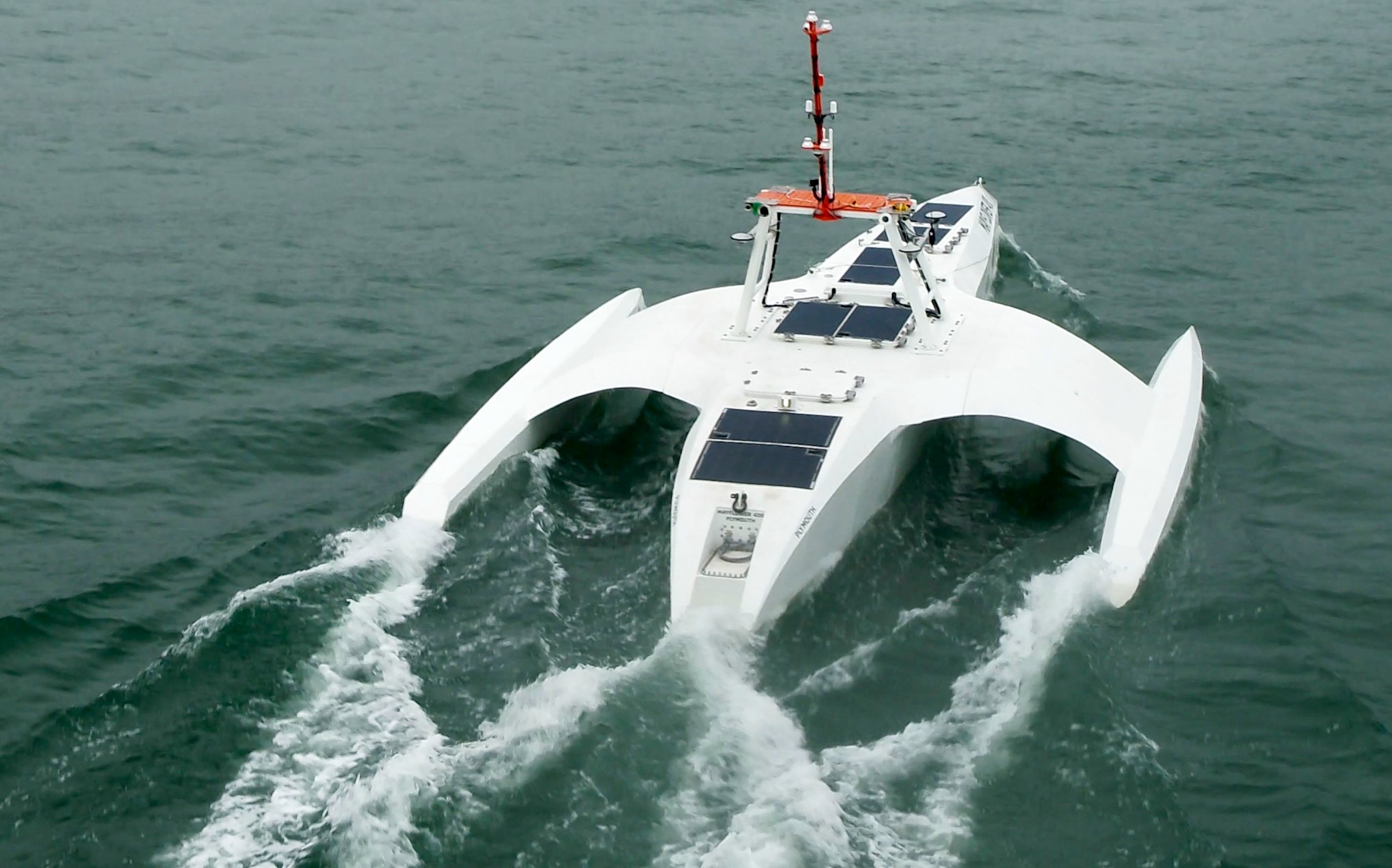
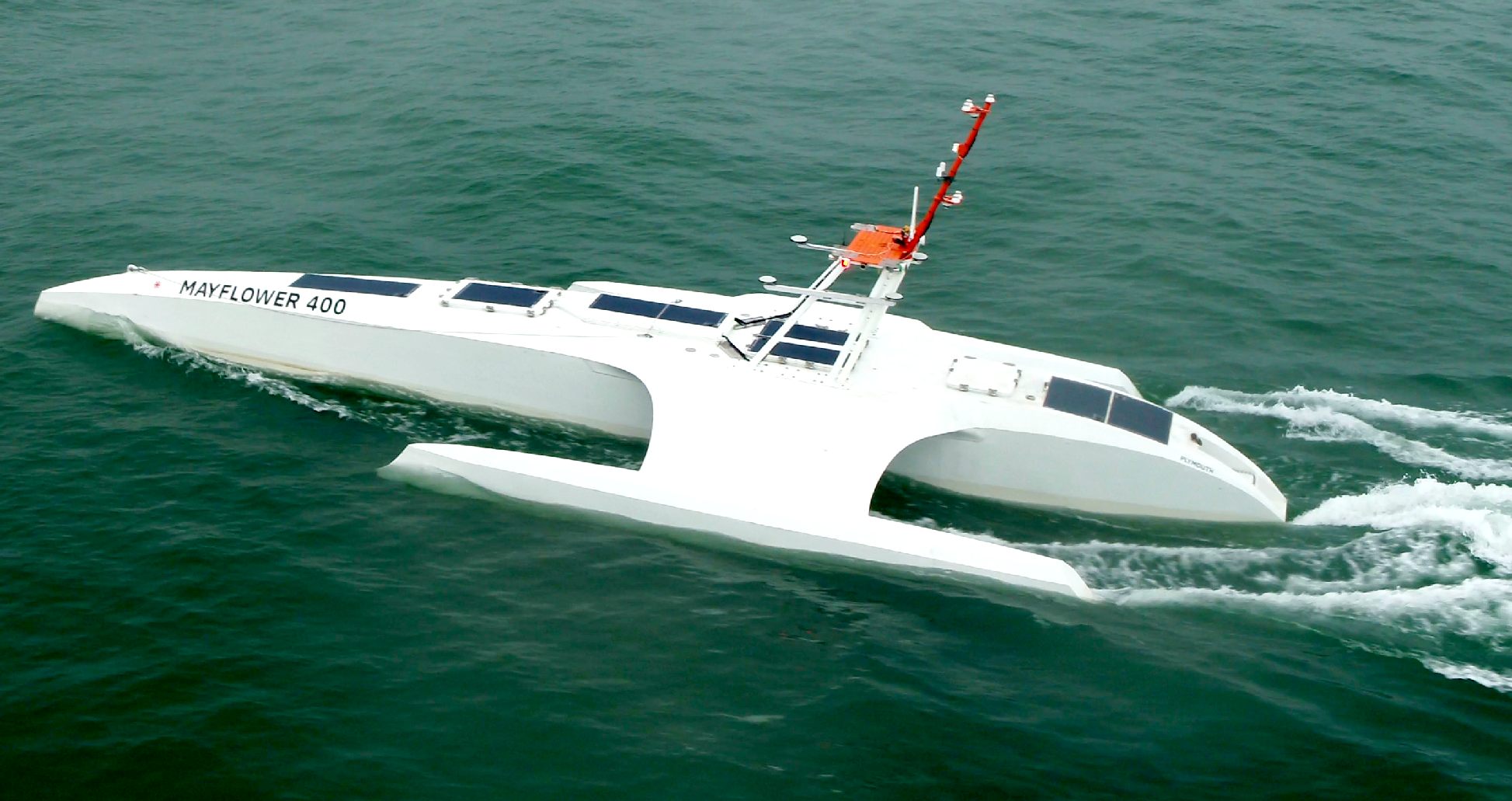
|
|
TRANSATLANTIC
EVENT CALENDAR 2021
|
|
The
IBM Mayflower
MAS 400 is an
autonomous
trimaran
part powered by a
diesel
engine, piloted by a solar powered artificially intelligent
computer
system developed by IBM called 'AI Captain.'
A
BIT OF HISTORY
The
first solar boat to travel around the world was the PlanetSolar,
coming home on the 4th of May 2012. Computing power was not as advanced
as it is today, when PlanetSolar set off on 27th September 2010,
following the Sunshine Route, first shown in London at the 1994/95 Boat
Show. Then in January 2013 a patent specification for a COLREGs
compliant, unmanned autonomous navigation system was filed by a BMS
engineer (now Foundation IP) with the suggestion in 'Claims' for using a solar
powered trimaran (patent granted 12 June 2019) as a suitable hull
configuration. This patent also included wind energy harvesting as
originally advertised for the Mayflower 400.
JOURNEY
TIME
The original wooden
30-meter Mayflower took 66 days to carry
the Pilgrims,
Founding Father's colonists
from the U.K. to what is now Cape Cod,
in the U.S., to escape draconian religious
persecutions after Henry
VIII passed laws to enable arrest of dissenters. The voyage would
have involved a lot of tacking,
because sailing ships cannot sail directly into the wind. But the new
sail-less aluminium
boat should take two to three weeks (14-21 days) for the voyage, depending on how strong
the prevailing trade
winds are, and assuming no technical glitches or marine accidents -
the whole point of a COLREGs
compliant navigation
system.

LINKS,
CONTACTS & REFERENCE
https://news.sky.com/story/the-star-trek-style-ship-that-may-change-the-way-we-explore-the-oceans-with-no-captain-or-crew-12288826#
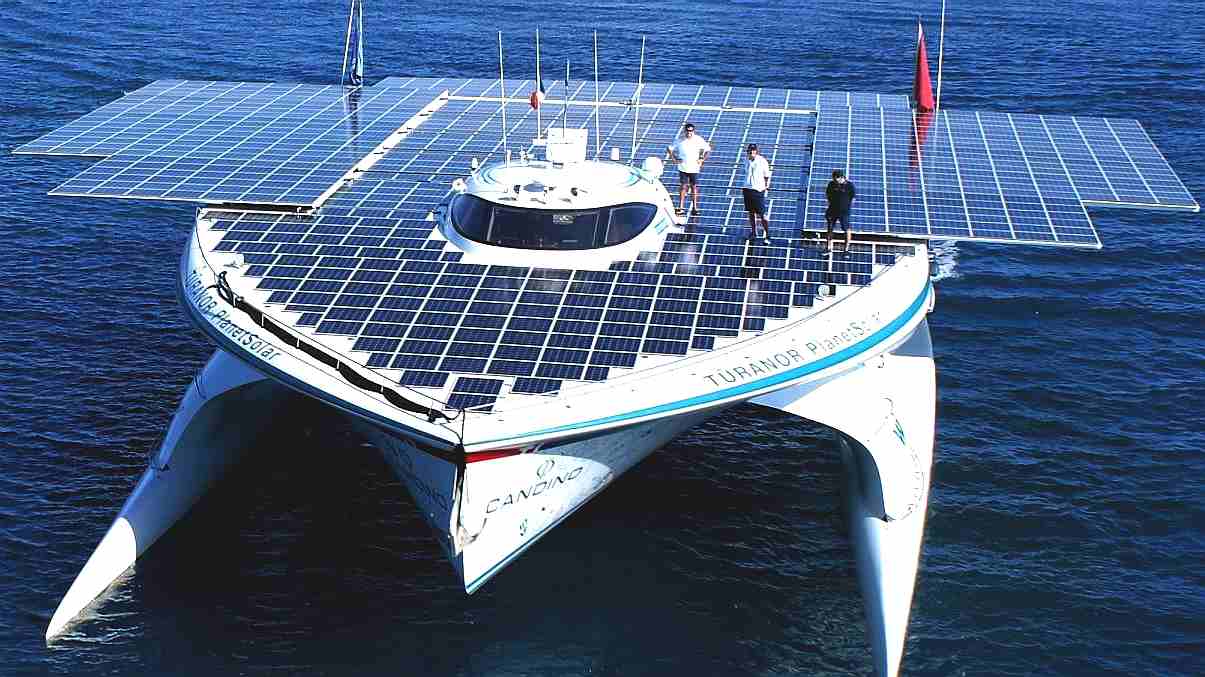
|
|
Please use our
A-Z INDEX to
navigate this site
This website is Copyright ©
2021 Jameson Hunter Ltd |









